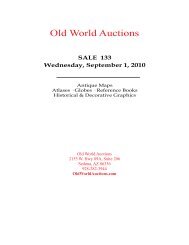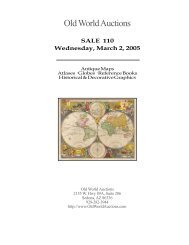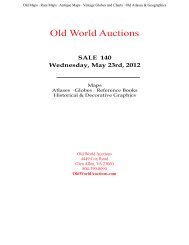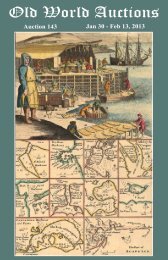PDF catalog - Old World Auctions
PDF catalog - Old World Auctions
PDF catalog - Old World Auctions
Create successful ePaper yourself
Turn your PDF publications into a flip-book with our unique Google optimized e-Paper software.
<strong>Old</strong> Maps · Rare Maps · Antique Maps · Vintage Globes and Charts · <strong>Old</strong> Atlases & Geographies25. <strong>World</strong> (Orbis Terrarum Nova et Accurata Tabula), Valck, Amsterdam, ca. 1700. 22.5 x 19”. (HC) This double-hemisphere world map is a stunning example of thebaroque style that was popular at the end of the 17th century. Surrounding the map are delightful allegorical scenes representing the four seasons: joyous Spring,industrious Summer, bucolic Autumn, and icy Winter. Valck based this map on his earlier Mappe-Monde Geo-Hydrographique, or Description Generale de GlobeTerrestre et Aquatique from 1686, which in turn was based on Jaillot’s influential world map of 1674. California appears as an island, and a large Terra Incognitasive Terra Esonis stretches from North America to Asia. Greenland is connected to North America. Australia, Van Diemen’s Land, and New Zealand are onlypartially delineated, and Australia appears almost connected to Terra dos Papos sive N. Guinea.Valck updated this edition to include the newly-discovered Mississippi basin as well as the conjectural Mer Glaciale, which appears to almost connect HudsonsBay with Mare Californie. Although the Great Lakes are still in a preliminary configuration, they are fully delineated. The southern continent has been completelyerased, and the mythical Lake Parime no longer appears in South America. Insets with polar projections and additional allegorical vignettes in the cusps completethe composition. Ref: Shirley #638. Attractive color with professional repairs to a long centerfold separation at bottom and a small hole in the center of the upperpolar projection. There are two small worm holes in the upper corners. Expertly remargined with period paper with a portion of neatline in facsimile. (B+)$6500-750026. <strong>World</strong> (Planisphaerium Terrestre cum Utroque Coelesti Hemisphaerio, sive Diversa Orbis Terraquei...), Zurner, Amsterdam, ca. 1700. 23 x 20”. (HC) This is astunning double hemisphere world map with up-to-date cartography for the period. California is shown as an island with an indistinct Fretum Anian and Terra Esonisabove it. There is a River of the West emptying into a small sea just northeast of California. Australia is shown to be separate from New Guinea, Carpentaria andDiemens Land. Nova Britannia is shown as a separate island off the coast of New Guinea with the notation that it was discovered by Dampier in 1700. Severalexplorer’s tracks are traced, including Magellan, Dampier, Tasman, Gaetani and Charmont. The map is enclosed in broad bands containing information on thewinds and climates. Tucked between the hemispheres are beautiful celestial maps and arrayed throughout the border are twenty-six smaller astronomical diagramsand world maps on various projections. At the bottom is a panorama illustrating tempests, earthquakes, tides, vortices, volcanoes with a textual commentary on thenatural phenomena depicted. Ref: Shirley #639. A slightly uneven impression in lower celestial hemisphere with a long centerfold separation at bottom that hasbeen professionally repaired. There are additional professional repairs in blank margins to small chips and tears, a few of which enter 1/8 - 1/2” into map. (B+)$4750-550027. <strong>World</strong> (Iter S. Francisci Xaverii Ex Europa in India, & Iaponiam), Scherer, Atlas Novus … Part IV, Munich, ca. 1700. 14 x 9.1”. (HC) This unusual and verydecorative world map is presented on an oval projection. Scherer, a devout Jesuit, produced his geographical compendium to depict the Catholic hierarchy and thespread of Jesuit missions throughout the world. This map marks the travels of St. Francis Xavier with views of his ship decorating each corner. The map depictsCalifornia as an island and hints at a northwest passage. Parts of Australia and New Zealand are shown in the South Pacific. The mythical island called CompagnieLand is illustrated east of Japan, which was supposedly discovered by Jean de Gama. Ref: Shirley #632. There is a minor printer’s crease to the right of the titlecartouche, and a tiny tear in bottom blank margin that has been closed on verso with archival tape. (A+) $1200-150028. <strong>World</strong> (Planisphaerium ex Polo Arctico tanquam centro Geometrice descriptu), Scherer, Novus Atlas, Munich, 1700. 7.3 x 9.2”. (HC) This interesting world mapis depicted on a north polar projection and features California as an island. South America includes several conjectural lakes, and in Africa the source of the NileRiver is shown as two large lakes south of the equator. New Guinea and Australia (Nova Hollandia) are only partially delineated. The Pacific Ocean is left largelyblank, with partial outlines of two landmasses: one northwest of North America and the other just east of Japan. Below the map are three astronomical diagrams.Ref: Shirley #634. Minor stains in blank margins. (A) $700-80029. <strong>World</strong> ([Mappa Geographica Universalis Figurae Oviformis]), Scherer, Atlas Novus, Munich, ca. 1705. 7.4 x 3.9”. (HC) This little map of the world showsb>California as an island. There is very little inland detail except for the large lakes and seas and the river systems. The Solomon Islands occupy the Pacific andmost of the Australian coastline is shown, here labeled Nova Hollandia. This map is the lower half of a sheet with a world map on Mercator’s projection aboveit, titled Mappa Geographica Universalis in Plano et Figura Quadrata. Heinrich Scherer, professor of mathematics at Munich, was a devout Jesuit whose workemphasizes the Catholic hierarchy and the spread of Jesuit missions throughout the world. There are a few faint spots in the image. Trimmed at top, with titlemissing. (B) $140-17030. <strong>World</strong> (Zee-Togten door Thomas Candys na de West Indien; en van daar Rondom den Gantzen A. Ardkloot Gedaan), Aa, Naauwkeurige versameling der gedenkwaardigstezee en landreysen…, Leiden, ca. 1706. 9 x 6”. (HC) This small, decorative world map tracks the voyage of Thomas Cavendish, an Englishman whocompleted the third circumnavigation in history from 1586-88, after Ferdinand Magellan and Sir Francis Drake. California is shown as an island, and the lessexplored South Pacific is cleverly hidden by a decorative title cartouche featuring a vignette of explorers preparing a feast. Published in van der Aa’s compilationof early voyages of exploration. Light, overall toning with a few minor spots and a partially repaired centerfold separation that just enters map border at top. Thetop margin has been extended to accommodate framing. (B+) $160-20031. <strong>World</strong> (Nova & Accuratissima Totius Terrarum Orbis Tabula Nautica Variatum Magneticarum Index Juxta Observationes Anno 1700 Habitas Constructa per Edm:Halley), Halley, Amsterdam, ca. 1740. 56.5 x 20.5”. (HC) Edmund Halley (1656-1742) was an English astronomer, meteorologist, and physicist best known forcalculating the orbit of the eponymous Halley’s Comet. In 1686 Halley became the first to depict trade winds and monsoons on a map, which appeared on his untitleddiagrammatic world map. Halley was granted temporary Captainship in the Royal Navy for his scientific voyage through the Atlantic on the ship Paramore,during which he investigated the laws governing the variation of the compass. He published his findings in General Chart of the Variation of the Compass (1701),a chart of the Atlantic ocean which was the first to use isogonic, or Halleyan, lines to show the pattern of magnetic variation. The following year Halley extendedhis chart to the western Pacific, using data from journals of voyages in the Indian Seas.Published by Reinier and Joshua Ottens, this world map on Mercator’s projection records both trade winds and magnetic variation, being the first map to representboth aspects of Halley’s ground-breaking work. Numerous explorers’ discoveries are noted throughout, and the route of Halley’s voyage is also shown. The interiorsof the continents are left largely blank, with place names focused on the coasts. Eastern Asia and the south Pacific are repeated on both sides of the map, andAustralia (Nouvelle Hollande), Tasmania (Pays de Diemen), New Guinea (Nouv’ Guine), and New Zealand (Nouvelle Zeelande) are only partially delineated. Alarge semi-circular inset of the North polar region is depicted in the south Pacific. There are two explanatory blocks of text in Latin and French at left, and a decorativecartouche at right dedicated to Queen Anne, who ascended the thrones of England, Scotland and Ireland in 1702. The decorative title cartouche is surmountedby female figures representing astronomy, navigation, and exploration. Printed on three sheets, joined. Ref: Suarez (Pacific) p.111, fig.104; Wagner (NW) #540;Shirley, p.xiv. An excellent example with two printer’s creases at bottom near polar inset and very minor soiling. There are a few minor fold separations confinedto the blank margins repaired with tissue on verso as well as several damp stains in blank margins, not affecting map. (A)$11000-1400032. <strong>World</strong> ([Untitled - <strong>World</strong>]), Jagen, Amsterdam, ca. 1741. 17.8 x 12”. (HC) Lovely double hemisphere from a Dutch Bible published by the Keur family. The mapis surrounded by allegorical representations of the continents based on Visscher. The Keur publishing family used Daniel Stoopendaal’s world map titled “WereltCaert” (Ref: Shirley #498) for 70 years in their Bibles. When the plate became worn, Jan van Jagen was commissioned to engrave a new plate. It was updated withCalifornia shown correctly as a peninsula, the addition of several Pacific islands and a corrected East Asian coastline. The northwest coast of North America is leftcompletely blank, Australia is partially mapped and there is only a hint of New Zealand. Diagrams of the Copernican and Ptolemaic solar systems rest betweenthe hemispheres. J. v. Jagen’s signature at bottom just left of center. Dutch text on verso. Ref: Poortman & Augusteijn #137. A very sharp impression and goodmargins all around. A centerfold separation that enters 1” into map image at bottom and a 3/4” tear adjacent to centerfold at bottom have both been professionallyrepaired. There are a few other tiny repaired tears in blank margins. (B+) $1200-140033. <strong>World</strong> (Basis Geographiae Recentioris Astronomica…), Doppelmayr/Homann, Atlas Coelestis, ca. 1742. 22.8 x 19.1”. (HC) Dopplemayr’s scarce world map isa unique combination of scientific and decorative cartography. The map is based on co-ordinates established for 142 places, which are shown in the tables aboveand below the double hemisphere map. The continents are shown in outline form without political detail. In North America California is an island, and there is ahint of a possible Northwest Passage from Hudson Bay to the Strait of Anian. In the Eastern Hemisphere only the western and northern coastlines of Australia areshown, and Japan is shown twice (once to illustrate Sanson’s error that placed it too far east). This is the second state with additional information from Leodium(Liege), Cadiz, Petropolis and Tornio added to the original 138 places in the tables. The richly engraved decorative elements are much more than mere embel-
















